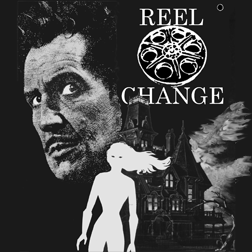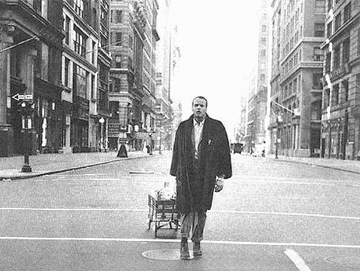 |
 |
 |
 |
 |
 |
 |
 |
 |

The Last Man on Earth is Not Alone

"You're dealing with very reduced elemental worlds - a little akin to the American Western. All the issues are easily defined, so they're kind of fables. And because of that, they have very strong metaphorical value. People can take whatever meaning they want from them. In Japan, they seemed to think of [Max] as a samurai. In France they saw him as a classic western hero. In Scandinavia, he was a Viking hero. And I suddenly realized, there's something else going on here. It tapped into some sort of energy. And it became one little piece of the mosaic of contemporary mythology. And in a way, I'm a servant of that. Despite my own creative vanities as a filmmaker, I saw that narrative has a larger purpose."
--George Miller on Mad Max, in Fade In: Vol. V, no. 4Every society has its own story that recounts the beginning of the world; likewise, each has a prophecy of how the world will end. For American popular mythology, the Western tells the Genesis story. The Civilized move West to tame the savage desert, bringing their Eastern ethics and moral codes and adapting them when necessary. The Western reminds Americans of what they have gone through in the past to arrive where they are now. Miller's "larger purpose" is to teach the lessons of the past to the generations that follow. Whether or not these are the true lessons of that time is unimportant; all that matters is for some version of the Western Code to remain as a thread uniting those stories of "the thrilling days of yesteryear."
Conversely, the Post-Apocalyptic Action Film's larger purpose seeks to teach the lessons of the future and warn of the possible resurgence of the wilderness, or at least the wildness that civilization has tamed both from without and from within. If the Western is indeed the Genesis Story of where America came from, the Post-Apocalyptic Action Film tells the Armageddon Story of where we are headed, and how to gain salvation in spite of this. Until recently, the Armageddon came naturally to Earth, either at the hands of a deity or by an organic calamity. It is only in the last century that mankind has shown the technological abilities to bring upon itself its own premature apocalypse. Once the threat of the end of the world had ceased to be out of our control, the end of the world no longer had the inescapable certainty of the hand of God. Technology, which had given mankind the power to destroy itself, had also given it a means with which to survive that destruction. While much, if not all of Science Fiction is based on a fear or at least a mistrust of technology, the Post-Apocalyptic Action Film shows the consequences that might occur if such warnings about technology are not heeded.
The Post-Apocalypse Film first appeared in the 1950s with such cautionary tales as Five (1951) and The World, The Flesh and The Devil (1959). Both of these films focused on a small group of atomic war survivors immediately following the disaster. The microcosmic aspects of these films comment not only on modern society, as in The World, The Flesh and The Devil's focus on race relations, but also on the imminent threat of nuclear conflict. These early films are dramas that treat the apocalypse as a serious issue and serve as a warning against further nuclear armament. This post-apocalyptic setting endured through La Jetee (1962) and The Last Man on Earth (1964). Retaining the cautionary nature of their predecessors, these films inject a measure of action that supercedes the human drama.
The true Post-Apocalyptic Action Film arrives with Planet of the Apes (1968). With a similar surprise ending as Teenage Caveman (1958), Planet of the Apes uses the post-apocalyptic setting as a backdrop for a rousing adventure. Only at the film's startling revelation that the planet of the apes is actually Earth in the far future, is there any explicit moralizing against nuclear war. Many "after-the-end" action films followed, including The mega Man (1971), A Boy and His Dog (1975), and The Ultimate Warrior (1975), along with four Planet of the Apes sequels. In these films, the disaster is well past, by years and sometimes even centuries. The cataclysmic disaster is no longer limited to nuclear threats; a population decimated by germ warfare sets the stage The mega Man, and the ecological disaster of The Ultimate Warrior is never fully explained. The end of the world is no longer an issue to be preached against, but rather merely a setting. It becomes almost a foregone conclusion that mankind will one day destroy itself.
The Post-Apocalyptic Action Film remained alive with such second-rate features as The People Who Own the Dark (1975) and Damnation Alley (1977), but in 1981, with the release of The Road Warrior, the genre entered a new age. A sequel to Mad Max (1979), The Road Warrior spawned numerous imitations after its huge international success. The Italian film industry was mostly responsible for the boom of Post-Apocalyptic Film in the early 1980s, much like the Spaghetti Westerns of the 1960s. Some are blatant copycats, like 2020: Texas Gladiator (1983) and After the Fall of New York (1983), while other Europeans simply borrowed the post-apocalyptic wasteland and created the rest as their own, for example the French-made Le Dernier Combat (1983). Some films like The Terminator (1983) glimpse the Post-Apocalyptic future and then attempt to rescue humanity before the possible future becomes a fact. The genre remained in a golden age into the mid-1980s, with the last film of this era being the conclusion of the Mad Max Trilogy, Mad Max Beyond Thunderdome (1985). There has not been such a proliferation of films since then, but not a year has gone by without the release of at least one Post-Apocalyptic Film.
Even with different disasters and consequences, Post-Apocalyptic films share enough common elements to invite comparison. The four most important elements that identify a Post-Apocalyptic Action Film are the setting of the Wasteland, the struggles of the surviving and reemerging civilization, the barbarians that threaten the civilization, and the hero caught between these two forces. For purposes of example, the Post-Apocalyptic Action Films discussed will be limited to films that take place significantly after a disaster brought on by mankind.
